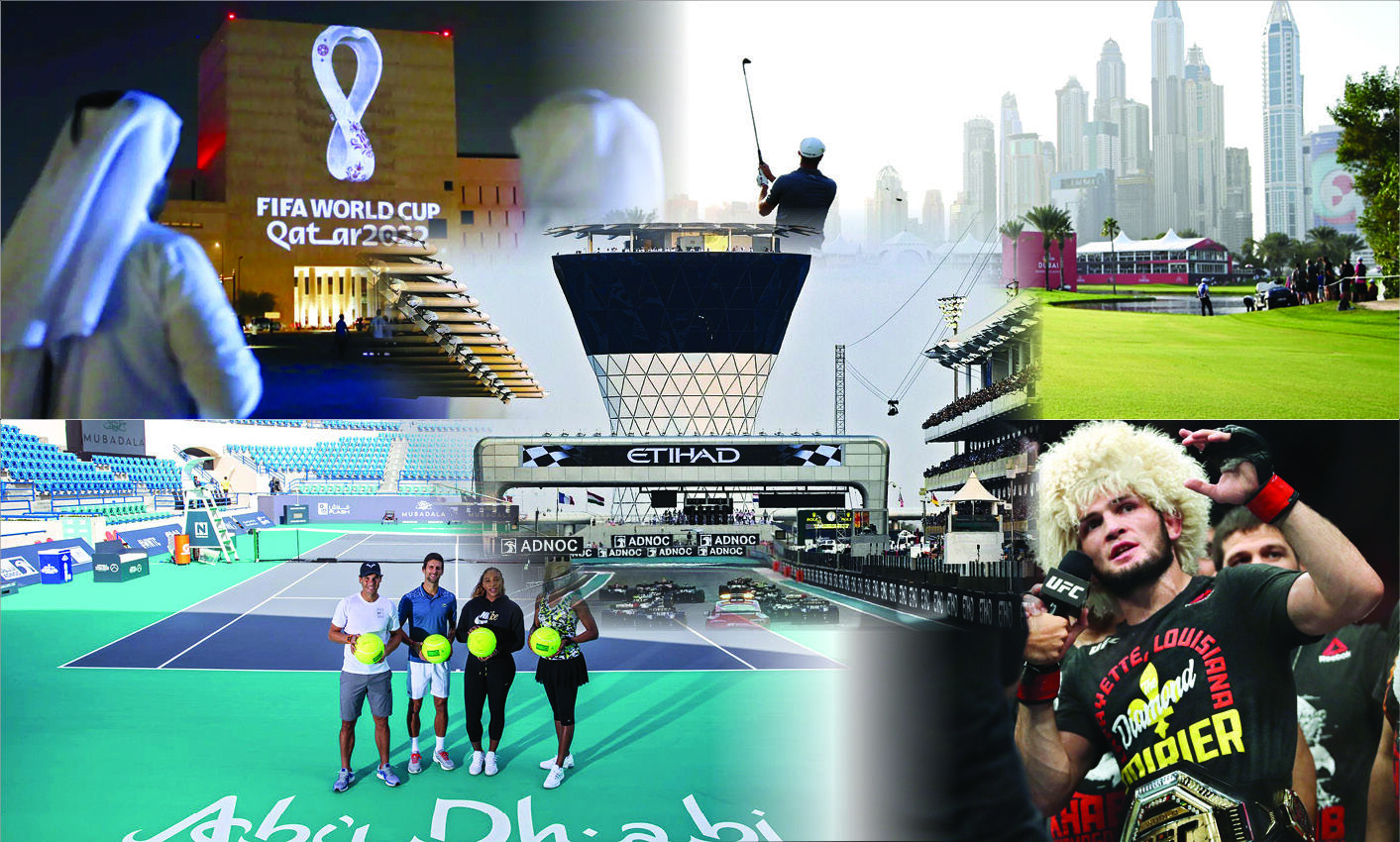Talking Shop: When oil runs thin
Humanity is turning to batteries and electric vehicles, while some are placing their faith in prayer and gas. The smarter ones, though, are tuning into sports

"I have a low tolerance for
people who complain about
things, but never do anything
to change them. This made me
conclude that the largest pool
of untapped natural resources
is human good intentions that
aren't translated into actions."
– Cindy Gallop
Who would have thought that the biggest sporting events in the world—be they football, cricket, Formula One, tennis, golf, and UFC (Ultimate Fighting Championship)—would be hosted in the Middle East? No one, but this is happening. A region unknown for sporting profligacy has emerged over the last few years alone as the new Mecca of sports yeoman-ship. How has this transformation happened? Who's behind this transcendence and who's the architect of this metamorphosis from nations thriving on once-flesh-chewing dinosaurs, now fossils-turned-into-fuel? Today, though, let's talk of the optimistic proclivities.
Given its messianic past, humankind, in a new world, is now being forced to take a U-turn and deep-dive for future survival and sustenance. Suddenly then, we have the richest, Ferrari- and Bugatti-obsessed nations purring and crooning to a new tune. It is time to turn to sports, they have averred, and are burning more dollars than you and I can dream of and propping up stadiums, sports arenas and related paraphernalia that is astounding the globe's senses.
In today's fast-diminishing global oil economy, the Middle East is turning into the world's fastest-growing sports tourism destination, valued at an estimated USD 600 billion, according to the World Trade Organisation. The oil-rich region has invested billions upon billions across the sporting world, a report by human rights organisation Grant Liberty says, from chess championships to golf and tennis. And let's not forget the Saudi Cup, the world's richest horse-racing event with prize money of USD 20 million, on which alone they have pumped in USD 60 million. We should all junk our cars and buy a horse before the largesse runs thin.
Sports, sports, sports...
In August of this year, the United Arab Emirates hosted the Asia Cup 2022. In the past few years, the UAE hosted many cricket events, including the T20 World Cup, the Indian Premier League and the Pakistan Super League. Admirably, the country hosted them during the peak of the COVID-19 pandemic and that made it a standalone region in organising sports events in adverse times. Hosting standout cricket fixtures is not foreign to the UAE. Cricket arrived in the region in 1981, when Sharjah started hosting elite international players well before hosting its first international tourney.
The focus has only widened; there's football, Formula One, tennis, golf and UFC (Ultimate Fighting Championship). Sharjah, Dubai, Abu Dhabi, Bahrain, Doha and Saudi Arabia are now the go-to destinations for sports extravaganzas. With the FIFA World Cup 2022 in full swing, the whole planet is now fixated on the Middle East. Qatar is playing host to the biggest tournament in the sporting world and the 2023 after-party is not to be missed either. There's everything from golf to tennis to mesmerizing Formula One action to keep anyone's sporting fix in check.
There's rugby too, with Rugby Sevens now becoming an intrinsic part of Dubai's fabric, and this carnival of sport is scheduled to go live in under a week. Then there's golf, with Dubai's now well-known Desert Classic at its top-class golf facilities. In January 2023, Rory McIlroy will join some of the sport's biggest names. Around the same time, the Dubai Duty-Free Tennis Championship will host some of the world's biggest stars. We also have the Dubai marathon, which will be flagged off in February next year. By the end of March, the world's best jockeys would have clocked up 21 competitive appearances between them at the Dubai World Cup, regarded as the pinnacle of horse racing events. Whew.
Icing on the cake
The scale of planning and investments is massive and to understand the sheer scale and grandeur, let's take a look at the ongoing celebration called the FIFA World Cup. Initially, estimates of the total cost for the grand event, including hotels, roads, rail network upgrades, public spaces and transport, and of course the seven new spanking stadiums, were around USD 220 billion, but according to Qatar's ambassador to Russia, the actual cost was USD 200 billion. To understand the mammoth number, each USD 1 billion is worth around Rs 8,000 crore. By any standards, that is an amount many, many times higher than that spent on any similar sporting event, ever.
Get a load of this—each of the seven new stadia and an eighth refurbished one, all training facilities and fan zones are equipped with solar-powered cooling technology to maintain a moderate temperature. All stadiums are eco-friendly and temperature-controlled. And finally, Qatar is home to less than 3 million people, so the legacy of the tournament has also been planned with care. All the stadiums have been built with modular elements, which will be reconfigured after the tournament. For instance, once the gala is over, 1,70,000 seats will be disassembled and provided to developing nations to help develop their sports infrastructure. As many as 22 new stadiums will be created in emerging economies and this will leave Qatar with enough stadiums for its domestic needs.
Since we are focussing on the FIFA World Cup 2022 and the stadium infrastructure already created for this event, let's mention the eight venues for this event that have cost around USD 6 billion; nearly Rs 50,000 crore. These jewels of modern football are the Al Bayt Stadium, Ahmad Bin Ali Stadium, Al Janoub Stadium, Khalifa International Stadium, Education City Stadium, 974 Stadium, Al Thumama Stadium and the Lusail Stadium, which will host the grand final ceremony.
Vision and foresight
Clearly then, a huge amount of planning and thinking has gone into moulding the Middle East into a sporting megalith. Geography has helped too, especially in the case of cricket tournaments. The short distance between stadiums is helpful, as players can play a match in Abu Dhabi and travel two hours to Dubai for the next match. The only one-hour travel distance between Dubai and Sharjah keeps players fresh throughout any tournament. The world-class infrastructure and the provision of indoor practice sessions do not let weather conditions impact players.
And finally, get a load of this; the stringent legal system in the region has ensured that from the 1980s till today, no rioting or fighting has ever been recorded in or after any match of cricket or football in the region. There has never been any record of anything illegal like black marketing of tickets or infringement of the privacy of players. The punitive laws in the region have ensured the smooth conduct of every single sporting event, ever—and the successful conduct of the T20 World Cup and IPL 2020 during the peak of the COVID-19 pandemic only increased the credibility of the region as a sports destination.
"If conservation of natural resources goes wrong, nothing else will go right," MS Swaminathan once said. He got it right, just as the Middle East is getting it right now from the sporting perspective. Decades before their precious oil reserves run dry, they have planned and evolved and continue to do so, preparing for a changed tomorrow. It started with Dubai, which began converting itself into a tourist and real estate haven as oil ran thin. Others have followed suit and an all but unbelievable transformation has already happened. A place which had no special identity in sports is now a go-to destination. Impressive indeed.
The writer is a veteran
journalist and communications
specialist. He can be reached on
Views expressed are personal



